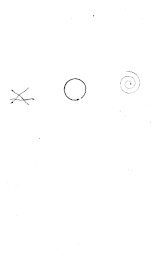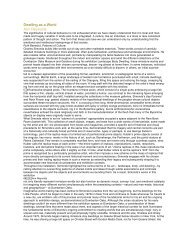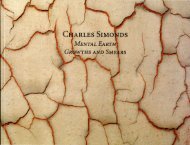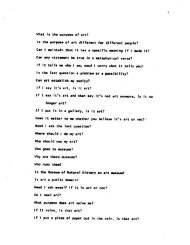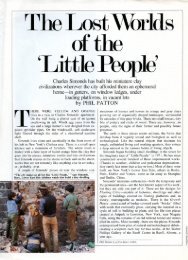Read Catalog - Charles Simonds
Read Catalog - Charles Simonds
Read Catalog - Charles Simonds
You also want an ePaper? Increase the reach of your titles
YUMPU automatically turns print PDFs into web optimized ePapers that Google loves.
Number 10 (pl. 41)<br />
From the first view of the Towers to the second we witness a<br />
direct extension, a more formal structural elaboration of the<br />
seven towers now resting upon a congruent (though technically<br />
wider) base. Beyond the low walls a reddish zone fixed by ritual<br />
markers encircles the complex, separating it from a brown,<br />
dusty surface from which nearly every feature of the living landscape<br />
in Number 9 has been effaced. All attention has been<br />
directed to the center tower.<br />
One approaches this tower circumspectly by means of a pathway,<br />
now slightly curved, which leads up to and over the low<br />
wall and connects with a steep bank of stairs spiraling up the<br />
left side and around to the back of the tower, terminating in a<br />
smaller cone which holds the ritual fire. The straight poles jutting<br />
out from the upper masonry link the central tower to the<br />
three smaller domes capped with vestigial buds, the only direct<br />
reference to the site as the Little People first saw it. But here<br />
again it is a matter first of emphasis, not exclusion: the fire altar<br />
also shares its gray color with the other three smooth conicaltopped<br />
towers. These three, like the corresponding domes in<br />
Number 9, are pierced by sharp angled stakes. (The artist sees<br />
these details as violent images, implying things hanging from<br />
the stakes as though sacrificed.) The masonry used throughout<br />
appears to be a rough gray stone quarried from a source we cannot<br />
see.l3<br />
Except for the rounded swelling of the towers and the details<br />
noted above, there is little softness or color in these buildings<br />
to remind us of Mother Earth; no doorways or windows to suggest<br />
that anyone actually lives within the sacred precinct; or<br />
that this is more than a specialized ritual architecture used only<br />
on specified days by priests. Between the grown and the built<br />
there remains only a brittle equilibrium, one literally of form,<br />
not substance. For the most part the earth is left down below,<br />
outside.<br />
Number 11 (pl. 42)<br />
In Number I I nearly everything which was round in Number<br />
ro is now square, sharp-cornered, angled straight and true.14<br />
The organic has become geometric, the flower a crystal. The<br />
architecture itself quickens the pace of the central event. The<br />
pathway, for instance, in these three sequential frames (Numbers<br />
IO-I2) has been progressively straightened (and likewise the<br />
steps), so that now one directly ascends the front face of the<br />
hexagonal tower up to the chamber upon whose roof we discover<br />
the only circle remaining in the complex, that of the inner<br />
altar itself. Even the six square towers are now nearly identical,<br />
save for the ritual poles. The masonry, too, seems distinguished<br />
by larger, more squarish blocks. The towers appear well-maintained,<br />
but the wall-now higher than before and physically<br />
separated from the squared plinths of the towers-is crumbling:<br />
its complex outline is blurred by courses of stone fallen both inward<br />
and outward upon a reddish sand which itself gradually<br />
fades further out into a rough pebbly land encircled vaguely<br />
with poles. We infer from this wall and its flanking entry gates<br />
a protocol, but by whom this is observed (or contested) we do<br />
not know.<br />
Number 12 (pl. 43)<br />
This last frame of the imaginary evolution of a landscape concludes<br />
what the artist presents to us, but it answers no questions.<br />
There are no surprise endings, no conclusion. What we<br />
see of the final Tower corresponds not to the preceding Tower,<br />
but to Number 7, the penultimate Circle. <strong>Simonds</strong> denies us a<br />
neat symmetry with its implications of ultimate unity and order.<br />
Instead we read the outline of the towers and fortifications<br />
from the shadows of fragmented walls and the pattern of blocks<br />
crumbling where they fell. Not a solitary pole commemorates<br />
this place. The ruins seem familiar-the ring of six square<br />
towers, the stone flower returned to earth. But the structure's<br />
center, its gender, is in doubt: whether circle, hexagon, or both<br />
(one erected over the other?) we once again must imagine. (Near<br />
to the ground the two strains are not dissimilar.) All we know<br />
with certainty is that again there is more to come, if only the<br />
wearing down of each block to dust.<br />
Footnotes<br />
I<br />
The painter Giorgio de Chirico recalled in 1919 11the strange<br />
and profound impression" made upon him as a child 11by a plate<br />
in an old book that bore the title The World Before the Flood<br />
.... The plate represented a landscape of the Tertiary period.<br />
Man was not yet present. I have often meditated upon the<br />
strange phenomenon of this absence of human beings in its<br />
metaphysical aspect" (Giorgio de Chirico, "On Metaphysical<br />
Art," reprinted in Metaphysical Art, Massimo Carra, ed., trans.<br />
Caroline Tisdall, New York: Praeger, 1971, p. 89).<br />
2<br />
What <strong>Simonds</strong> does visually in the second landscape is similar<br />
to the description of sacred space in Mircea Eliade's The Sacred<br />
and the Profane: The Nature of Religion, New York: Harcourt,<br />
Brace&. World, Inc., 1959, particularly pp. 20-24. 11The discovery<br />
or projection of a fixed point-the center-is equivalent to<br />
the creation of the world .... "For Eliade's 11religious man," the<br />
fixed point (from which follows orientation in the midst of a<br />
chaotic world) is revealed in a hierophany, or 11the act of manifestation<br />
of the sacred." Once established, the center becomes<br />
the point of reference for all activities and literally 11the center<br />
of the world," "the navel of the earth," and similar names from<br />
many different cultures. It is from an understanding of such<br />
basic principles that <strong>Simonds</strong> proceeds to model his own interpretations<br />
of these cosmological images.<br />
7I



